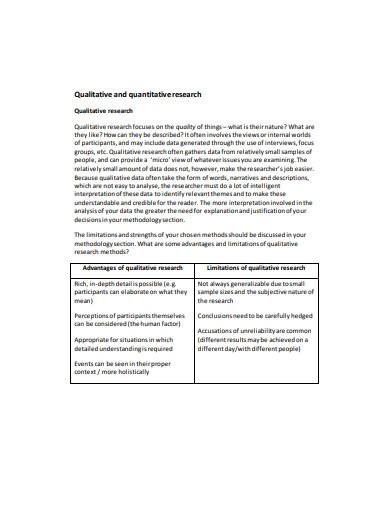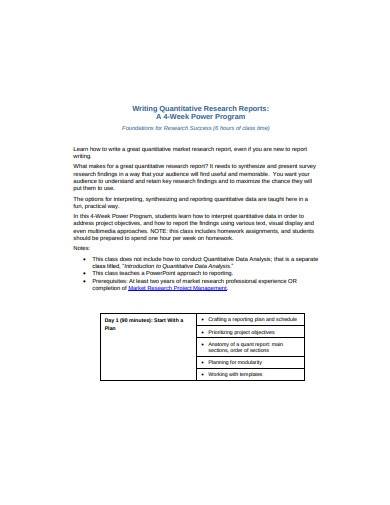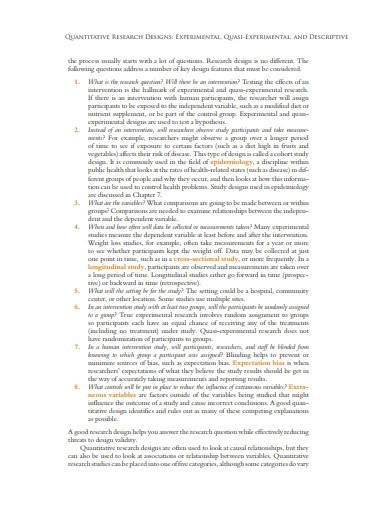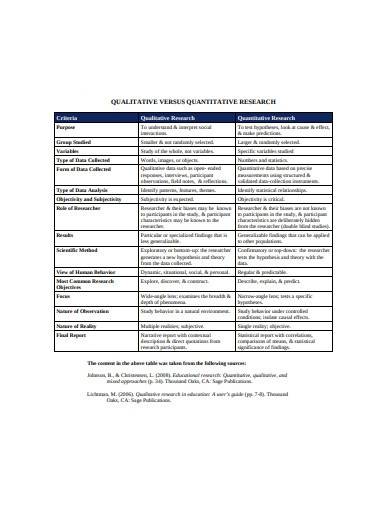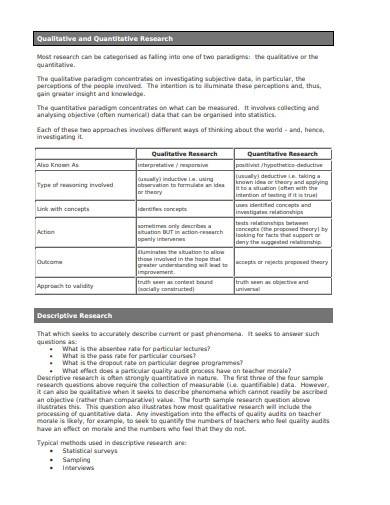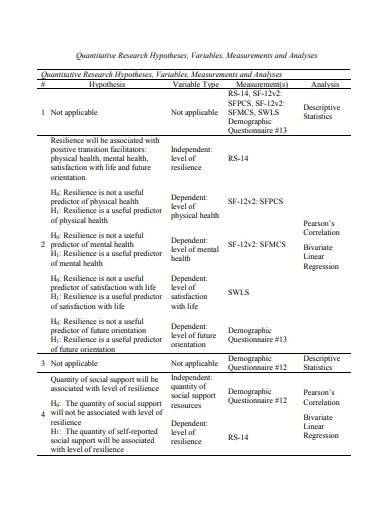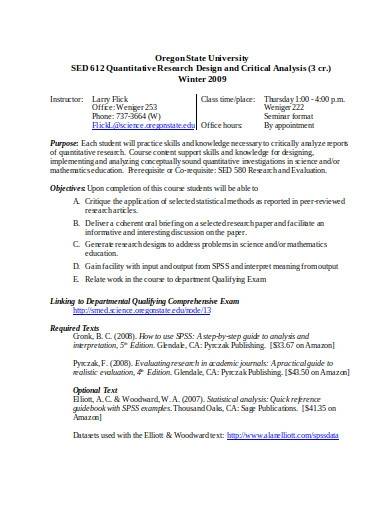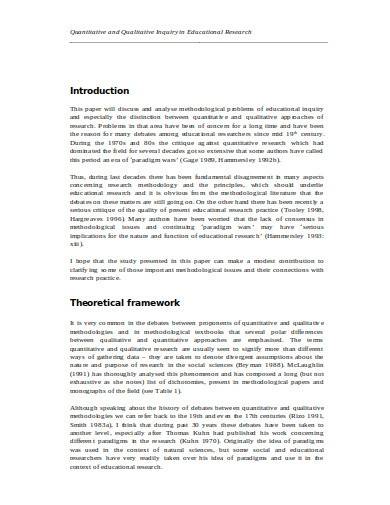Even the most straightforward questions could be difficult to answer, especially if it takes facts to prove the reasons behind it. In case one of these days, your friend asks you, “What makes an airplane fly?”, you can quickly make a conclusion of it having wings. However, an airplane flies not solely because of its wings, but also it allows air to flow over them by rapidly moving. Notice that there are one or two ways to answer questions and to solve problems too. That said, to come up with statistics as proof, you need to back it up with quantitative research results so that it will be irrefutable. How does it work? Find out below.
FREE 9+ Quantitative Research Samples & Templates in MS Word | PDF
1. Quantitative & Qualitative Research Template
2. Quantitative Research Report
3. Quantitative Descriptive Research
4. Formal Quantitative Research
5. Sample Qualitative and Quantitative Research
6. Quantitative Research Format Template
7. Quantitative Descriptive Analysis Research
8. Sample Quantitative Research Design
9. Quantitative Educational Research
10. Qualitative and Quantitative Research Methods
What Is Quantitative Research?
Finding answers is a process like discovering facts about a social phenomenon. With that, researchers use two types of research methods to deliver results—qualitative and quantitative. When it comes to a more structured collection of data, result analysts use quantitative research since it generates numerical statistics from a larger population of respondents. The statistics will be the platform in quantifying patterns, characteristics, trends, opinions, and other variables. Moreover, collecting data for quantitative research involves surveys, interviews, studies, interceptions, and systematic observations.
Marketing: The Industry’s Most Used Quantitative Methods
Research papers are common academic requirements. But when it comes to finding the right solutions, the marketing industry uses few quantitative research methodologies to influence their undertakings. According to a report by Statista, the industry’s top three most used traditional quantitative methodologies are online surveys, mobile surveys, and computer-aided telephone interviews (CATI) with numbers 79%, 53%, and 30%, respectively. The source surveyed in the third and fourth quarters of 2018. Some quantitative methodologies include a face-to-face interview, computer-assisted personal interview (CAPI), biometrics/neuro-marketing, mail, automated measures/people meters, and other quantitative techniques.
How to Make Quantitative Research
Unlike qualitative research that assumes negotiated reality, quantitative research is more on numerical and statistical interferences. That makes this research type to be technically formulated. Dealing with large quantities would not be easy. With this, the researchers should allocate more time for collecting data and processing results, and after that, continuing with the research means arranging the outcomes into an orderly manner. The simplest way around this is to narrow down your topic so that you can focus on detailed approaches. So what are you waiting for, let us take you deeper to quantitative research making, more on this below:
1. Choose a Research Type
The structure of the quantitative research, as well as its delivery of the message to the readers, reflects on its type. Know that you can write the research by describing, comparing, and relating the collected data. With this, you will have ideas on your word choice and phrasing to plan for the research question. Creating the research questions means you have to rely on the issues that you want to solve. In other words, it is the subject that you want to study and what concerns you the most. Furthermore, it will be your entry into your research project.
2. Develop the Topic
Since you have started the project with a research question, you can develop the topic at the same time. If providing the research question seems complicated, going back at it after you developed the topic is doable. Though it will take extra comprehension to establish a research topic without the questions, you can still deliver by reading textbooks, periodicals, sample reports, existing researches, and other online references. Think of a topic that will not bore you and your team as you try to complete the research project. An uninteresting research topic could take your drive away and demotivate your team without even finishing the project.
3. Identify the Variables
The research variables are the elements that have direct cause and effect on your study. Why is it important to know the variables? Because these variables are the flesh of the quantitative research and without it, the paper that you are to make becomes unconvincing. Remember that you are looking for answers that are based on facts and real-time results. Not considering variables means neglecting a factor that can guide you through the project. More so, select the variables that work best for your research topic. If not, it could mislead your project.
4. Select the Research Structure
Structuring your quantitative research makes it easy-to-understand. To do that, you have to consider a few things. First, you have to consider what you aim when writing the research question. That way, you can come up with a process in organizing the content of the research. Second, stick to the variables and other elements involved in the project. If you do not do this, the components of your research paper will be all over the place, and that is the last thing you would want to happen. Finally, for a well-structured quantitative research paper, all components must in order and presentable.
FAQs
What are the four types of quantitative research?
Quantitative research has four types, and it includes descriptive, correlational, quasi-experimental, and experimental.
What is the quantitative research design?
Quantitative research design aims to discover the number of people who think, act, or feel similar to a certain kind of way.
Why is quantitative data important?
All quantitative data are derived from a large number of respondents. It is important because it provides details that affect decision makings for individuals and organizations.
They say that some questions are better left unanswered. But that would not work for most of us. Answers are an essential part of our lives. In fact, it has an impact on our daily hassles. Even in deciding which detergent to buy, we based our purchase on its claims. We choose a route going to our work because we are sure it leads there. Without answers, we will be left on the guess. Settling for uncertainty is not what we are here for, but proving measurable reality is. Quantitative research provides answers based on facts and statistics that are unquestionable. It encourages everyone to remain curious and look for proof that makes life easier on the go.
Related Posts
FREE 10+ Concurrent Validity Samples & Templates in MS Word | PDF
FREE 10+ Resource Tracking Samples & Templates in MS Word | PDF
FREE 4+ Clinical Case Study Samples & Templates in PDF
FREE 10+ Content Validity Samples & Templates in PDF
FREE 10+ Construct Validity Samples & Templates in MS Word | PDF
FREE 10+ Code of Human Research Ethics Samples & Templates in MS Word | PDF
FREE 10+ Biography Research Report Samples and Templates in PDF
FREE 10+ System Documentation Samples & Templates in MS Word | PDF
FREE 10+ Process Document Samples & Templates in MS Word | PDF
FREE 10+ Action Research Samples & Templates in PDF
FREE 10+ Longitudinal Research Samples & Templates in PDF | MS Word
FREE 10+ Causal Research Samples & Templates in MS Word | PDF
FREE 10+ Client Discovery Samples & Templates in MS Word | PDF
FREE 10+ Null Hypothesis Samples & Templates in MS Word | PDF
FREE 9+ Product Knowledge Samples & Templates in PDF

